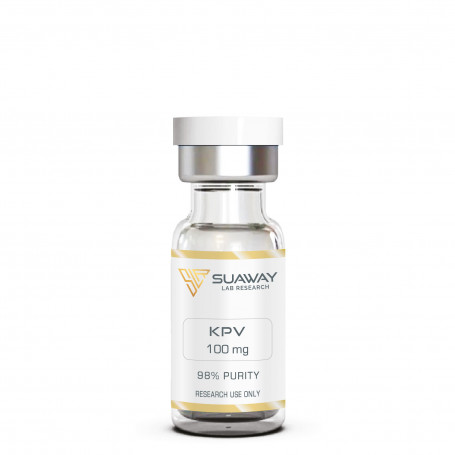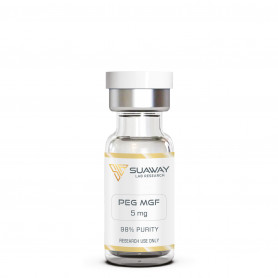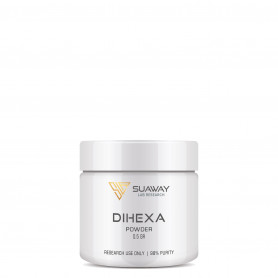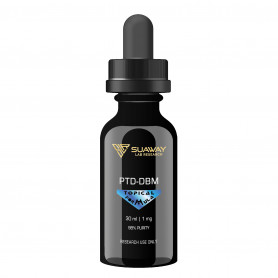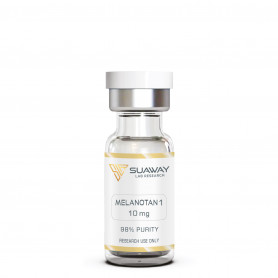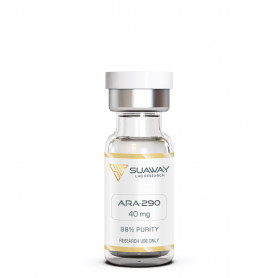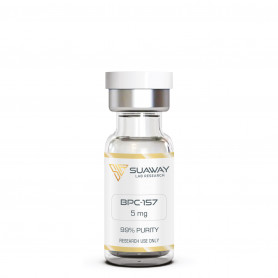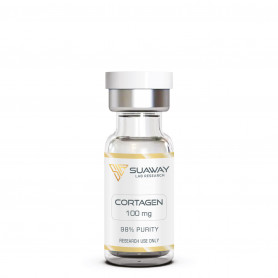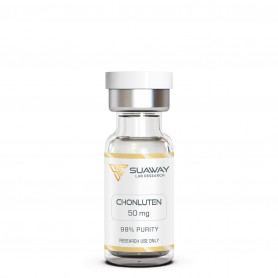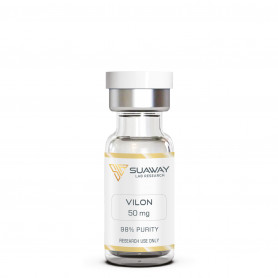KPV - 100 mg
KPV is a powerful peptide that inhibits the inflammatory response. The peptide has shown significant promise in treating inflammatory bowel disease, which is the area of study now receiving the greatest attention. KPV has been demonstrated to be both safe and effective in experiments conducted on animals when it was given in the following ways: orally, intravenously, subcutaneously, and transdermally. In addition, research on wound healing suggests that KPV, as well as other alpha-MSH compounds, may provide a variety of advantages, including the acceleration of wound healing, the reduction of infection, the combating of inflammation, and the production of superior aesthetic outcomes.
According to research, KPV is helpful for the following:
- Cystic acne
- Acne in general
- Crohn's disease
- Ulcerative colitis
- Irritable bowel syndrome
- Eczema - Psoriasis
- Mold
- Lyme
- Potential help with multiple sclerosis
- Inflammatory skin and eye conditions
- Allergic asthma
- Arthritis.
Description
STRUCTURE
Sequence: Lys-Pro-Val
Molecular Formula: C16H30N4O4
Molecular Weight: 342.43 g/mol
CAS: 67727-97-3
Peptide purity: Greater than 98%
Other details: No TFA Salt
Storage: Lyophilized peptide must be stored at -20°C and peptide solution at 4°C.
kPV has good oral and excellent subcutaneous bioavailability.
DESCRITPION
KPV is the C-terminal peptide fragment of alpha-melanocyte stimulating hormone (alpha-MSH). It has been discovered that the peptide KPV, composed of the amino acids lysine, proline, and valine, may significantly reduce inflammation. Active research is being conducted on the peptide as a possible therapy for treating inflammatory bowel disease. There is evidence that it has powerful anti-inflammatory action in the central nervous system, the gastrointestinal tract, the lungs, the cardiovascular system, and the joints. Since KPV is a very short peptide, it may be administered in various ways, including orally, intravenously, and even via the skin (transdermally).
The fact that the peptide may lower intestinal inflammation is perhaps the most significant result from KPV research. In mouse models of inflammatory bowel disease (IBD), KPV shows robust results, reducing inflammatory infiltrates, MPO activity, and overall histological evidence of inflammation. In the research, mice given KPV had a more rapid recovery and a more noticeable increase in their body weight than mice given a placebo. In animal models, further study on KPV has shown that it significantly reduces the levels of the inflammatory protein known as TNF-alpha, which speeds up the process of mucosal healing and reduces inflammation.
According to recent studies' findings, KPV affects more than only TNF-alpha, which is one kind of inflammatory mediator. Additionally, the peptide inhibits the activity of both NF-kappaB and mitogen-activated protein kinase. Inflammatory alterations in the gut may be mitigated by these effects, which operate in conjunction with TNF-alpha suppression. Compared to the controls, mice given KPV treatment had significantly reduced levels of colonic infiltration with normal colon lengths.
The fact that KPV only seems to have an impact when there is an extreme level of inflammation is an interesting finding. In cases of inflammatory bowel disease (IBD), this points to the possibility that KPV might be a beneficial treatment for either prevention or maintenance. Since it has no impact, it is safe to consume even when no activity occurs. If taken regularly, the peptide will be available appropriately and only expelled when it is no longer required. Didier Merlin, who has led a significant amount of research into the potential GI benefits of KPV, recently discovered that the peptide enters small intestinal cells via PepT1. This is a protein channel that is only expressed in any real quantity in the intestine during inflammatory states. It is possible that this aids in understanding why KPV is much more effective in situations with inflammation.
KPV is an effective anti-inflammatory agent and fever reducer in studies conducted on rabbits as far back as 1984. (antipyretic). In this particular scenario, however, the efficacy of KPV was lower than that of the whole alpha-MSH molecule. This led scientists of the time to speculate that KPV was missing some component of the alpha-MSH molecule, which is required for the virus to exert its full antipyretic effect. After then, decades of the study were devoted to examining the many different altered forms of alpha-MSH.
The fact that alpha-MSH and many of its counterparts all lower inflammation in a broad array of diseases is maybe the most important thing that researchers have taken away from these testing. Fever, irritant and allergic contact dermatitis, vasculitis, fibrosis, arthritis, and inflammation of the eyes, brain, lungs, or gastrointestinal system have all been studied with the molecules thus far. Alpha-MSH offers the most powerful anti-treatment, no matter the circumstance. Unfortunately, it has one big negative side effect: it induces pigmentation of the skin. On the other hand, KPV doesn't have this particular adverse impact. And even though KPV is not as powerful as the intact alpha-MSH, the absence of any negative side effects implies that increasing levels to attain the desired target effects is theoretically achievable in most situations.
Since the KPV section is responsible for the vast majority of the anti-inflammatory actions of alpha-MSH, the difference in efficacy has been determined to be, at best, negligible. However, it is interesting to note that the parent molecule seems more effective in inhibiting the late-stage inflammatory response. When it comes to the condition known as contact dermatitis, for example, alpha-MSH performs a better job of avoiding an allergic inflammatory reaction at a time point that is two weeks after the original exposure. This lends credence to the hypothesis that alpha-MSH could influence some part of immune regulation distinct from the acute inflammatory response.
The physiological process of healing a wound is rather complicated. Inflammation, proliferation, and remodeling are the three broad stages that may be distinguished in wound healing, as determined by scientific research. Each phase is distinguished from the others by variations in the cell populations or cytokine concentrations present. Each phase also provides a distinct chemical and physiological environment in which possible interventions may be implemented. According to research, even though different skin cell subtypes are present at each stage of the wound healing process, the majority of these cells express a melanocortin 1 receptor (MC1R) that binds alpha-melanocyte-stimulating hormone. This is true even though each process stage is characterized by a different skin cell subtype. This, of course, also indicates that the kinds mentioned above of cells can bind alpha-MSH analogs such as KPV and KdPT.
The fact that these alpha-MSH derivatives maintain some of the features of alpha-MSH while being devoid of others demonstrates that they may be useful in wound healing. For example, KPV has the same pro-inflammatory characteristics as alpha-MSH but does not inherit its parent peptide's ability to induce pigmentation in cells. Because of this, KPV is an excellent option for enhancing wound healing while avoiding the skin-altering properties often linked with the creation of natural scars (a phenomenon disproportionately affecting darker-skinned individuals).
One of the reasons that KPV is anti-inflammatory is that it participates in the innate immune response against two common skin pathogens. According to research conducted, KPV is capable of preventing the development of Staphylococcus aureus as well as Candida albicans. Because these effects are seen at physiological concentrations, KPV has the potential to serve as an efficient agent for the prevention of infection in the context of severe wounds such as burns. In contrast to other prodrugs, which may hinder the body's capacity to defend itself against infection, KPV has the virtue of not having this effect. As a result, the KPV exhibits anti-inflammatory and antibacterial properties. It would suggest that KPV can minimize the kind of systemic inflammation that might result in the production of hypertrophic scars (such as keloid scars). This kind of scarring is distinguished from others by the pervasive presence of macrophages, TNF immunoreactivity, and the number of neutrophils. In this particular context, alpha-MSH administration results in less severe inflammatory responses and smaller, less noticeable scars.
According to the findings of Dr. Didier Merlin, the capacity of KPV to modify collagen metabolism seems to be the source of at least some of the benefits it provides in lowering the prominence of scars. Alpha-MSH and its equivalents can decrease the formation of collagen type 1 by suppressing the release of IL-8. It has been shown that individuals more predisposed to keloid development and hypertrophic scarring had lower levels of MC1R mRNA expression in dermal fibroblasts. Because of this, it is essential that this be the case during the last stage of wound healing, which is remodeling.
Although alpha-MSH is the more powerful of the two molecules, it has one significant drawback compared to KPV: it produces skin pigmentation. KPV does not have this drawback. This adverse impact has been sufficient to deter researchers from continuing their investigation of intact alpha-MSH as just a possible anti-inflammatory. KPV is preferred because it maintains most of the anti-inflammatory characteristics of alpha-MSH while having none of the negative effects associated with alpha-MSH.
The pro effects of KPV seem to be mediated via a different route than alpha-MSH, which is another crucial point to keep in mind regarding this topic. KPV does not bind to particular melanocortin receptors in contrast to alpha-MSH, which does so. Studies conducted on mice support this theory by demonstrating that inhibiting the MC3/4 receptors, which are responsible for mediating the pro effects of alpha-MSH, does not influence the anti-inflammatory effects caused by KPV. To be more specific, inhibiting the activity of these receptors does not prevent the migratory leukocyte effects caused by KPV.
The simplicity with that the peptide may be delivered is another attractive quality of the KPV. It has been shown via research conducted on animal models that KPV may be safely provided in various ways, including orally, subcutaneously, and through injection (either peripherally or centrally). Recent studies that were conducted similarly have shown that KPV may be successfully delivered trans-dermally. It is not merely a question of convenience to be able to deliver medicine in a variety of different ways. The anti-inflammatory properties of the peptide might be focused in different areas depending on how it is administered, which can change how well it works.
REFERENCES
T. Brzoska et al., "Terminal signal: anti-inflammatory effects of α-melanocyte-stimulating hormone related peptides beyond the pharmacophore" [PubMed]
G. Dalmasso et al., "PepT1-mediated tripeptide KPV uptake reduces intestinal inflammation" [PubMed]
K. Pawar et al., "Transdermal Iontophoretic Delivery of Lysine-Proline-Valine (KPV) Peptide Across Microporated Human Skin" [PubMed]
M.F. Masman et al., "Synthesis and conformational analysis of His-Phe-Arg-Trp-NH2 and analogues with antifungal properties" [PubMed]
M. Schiller et al., "Human dermal fibroblasts express prohormone convertases 1 and 2 and produce proopiomelanocortin-derived peptides" [PubMed]
M.E. Hiltz et al., "Antiinflammatory activity of a COOH-terminal fragment of the neuropeptide alpha-MSH" [PubMed]
T. Brzoska et al., "Alpha-melanocyte-stimulating hormone and related tripeptides: biochemistry, antiinflammatory and protective effects in vitro and in vivo, and future perspectives for the treatment of immune-mediated inflammatory diseases" [PubMed]
M. Cutuli et al., "Antimicrobial effects of alpha-MSH peptides" [PubMed]
S.J. Getting et al., "Dissection of the Anti-Inflammatory Effect of the Core and C-Terminal (KPV) -Melanocyte-Stimulating Hormone Peptides" [Journal of Pharmacology and Experimental Therapeutics]
B. Xiao et al., "Orally Targeted Delivery of Tripeptide KPV via Hyaluronic Acid-Functionalized Nanoparticles Efficiently Alleviates Ulcerative Colitis" [PubMed]
K.S. De Souza et al., "Improved cutaneous wound healing after intraperitoneal injection of alpha-melanocyte-stimulating hormone" [PubMed]
K. Kannengiesser et al., "Melanocortin-derived tripeptide KPV has anti-inflammatory potential in murine models of inflammatory bowel disease" [Inflammatory Bowel Diseases]
T.A. Luger et al., "alpha-MSH related peptides: a new class of anti-inflammatory and immunomodulating drugs" [PubMed]
C. Lonati et al., "Modulatory effects of NDP-MSH in the regenerating liver after partial hepatectomy in rats" [PubMed]
G. Colombo et al., "Gene expression profiling reveals multiple protective influences of the peptide alpha-melanocyte-stimulating hormone in experimental heart transplantation" [PubMed]
G. Colombo et al., "Production and effects of alpha-melanocyte-stimulating hormone during acute lung injury" [PubMed]
DISCLAIMER
This product is intendend for lab research and development use only. These studies are performed outside of the body. This product is not medicines or drugs and has not been approved by the FDA or EMA to prevent, treat or cure any medical condition, ailment or disease. Bodily introduction of any kind into humans or animals is strictly forbidden by law. This product should only be handled by licensed, qualified professionals.
All product information provided on this website is for informational and educational purposes only.

